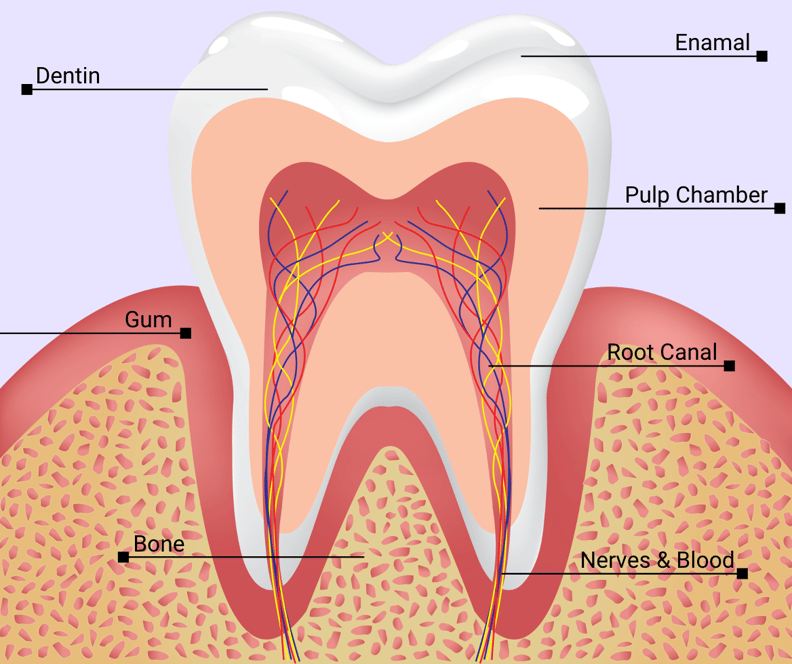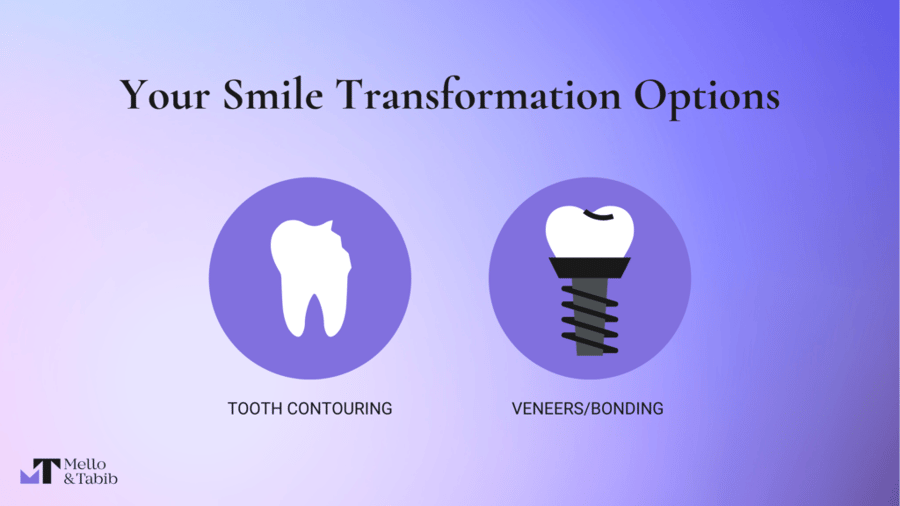
Tooth contouring, also known as enameloplasty, is a popular cosmetic dental procedure that can make a big difference in your smile. But how much can actually be done with this technique?
At NYC Smile Design, we’ve seen firsthand the transformative effects of tooth contouring on our patients’ smiles. If you’re thinking about tooth contouring, it’s important to know what it can and cannot do for you.
This blog aims to shed light on the scope and limitations of tooth contouring, helping you determine if this procedure aligns with your cosmetic dental goals.
What is Tooth Contouring?
Tooth contouring, or enameloplasty, is a cosmetic dental procedure where a dentist skillfully reshapes your teeth by carefully removing small amounts of tooth enamel. The process is subtle yet effective, focusing on making minor adjustments to improve the overall appearance of your teeth. It’s particularly useful for correcting small imperfections that can have a big impact on your smile.

The procedure typically addresses issues like small chips, which can occur from everyday activities or minor accidents. By smoothing out these chips, contouring can restore a more uniform and pleasing appearance to your teeth. It’s also effective in adjusting uneven tooth lengths, which can be a result of genetics, wear over time, or previous dental issues. By reshaping the ends of these teeth, contouring can create a more harmonious and balanced smile.
In addition to chips and uneven lengths, tooth contouring can also correct slight overlaps. Overlapping teeth might be more prone to plaque accumulation and can sometimes affect your bite. Careful contouring in these areas not only enhances the aesthetics of your smile but can also contribute to better oral hygiene and dental health.
Overall, tooth contouring is a minimally invasive, quick, and often pain-free procedure that can significantly improve the look of your smile. By understanding its capabilities and limitations, you can decide if it’s the right choice for your dental needs.
How Much Enamel Can Be Removed When Tooth Contouring?
In tooth contouring, subtlety is crucial. The procedure involves the careful removal of enamel, which is the tooth’s hard, outermost layer. However, only a small amount can be safely removed without compromising the health and integrity of the tooth. Typically, dentists will remove just a few 10ths of a millimeter of enamel, sufficient to make a noticeable improvement while maintaining the tooth’s strength and structure.

The exact amount of enamel that can be removed varies depending on individual factors such as the thickness of your enamel and the overall health of your teeth. Each person’s enamel thickness can differ, with some having more enamel to work with than others. This natural variation plays a significant role in determining how much contouring can be safely done.
Additionally, the overall health of your teeth is a determining factor. If your teeth have undergone previous dental work, such as fillings or restorations, or if there are signs of decay or weakness, the dentist may need to be more conservative in the amount of enamel removed.
It’s also worth noting that the removal of enamel is irreversible. Once it’s gone, it doesn’t regenerate. Therefore, dentists approach tooth contouring with a conservative mindset, ensuring they enhance your smile while preserving as much of the natural tooth structure as possible.
The Goal of Tooth Contouring
The main goal of tooth contouring is to improve the appearance of your teeth without compromising their function or health. It’s best for making minor adjustments rather than major changes. For example, it can smooth out a small chip or slightly reshape a pointy tooth.
In essence, the amount of enamel removed during tooth contouring is carefully calculated to balance aesthetic improvement with the long-term health of your teeth. This careful approach ensures that your smile is not only more attractive but also remains strong and healthy.

Limitations to Consider
- Not for Major Changes: If you’re looking for a dramatic change, tooth contouring might not be enough. It’s not suitable for making big alterations in tooth size or shape.
- Enamel Thickness Matters: Since contouring involves removing enamel, the amount that can be removed depends on how thick your enamel is. Not everyone has the same amount of enamel to work with.
- Irreversible Process: Once enamel is removed, it can’t be replaced. So, tooth contouring is a permanent change.
When Tooth Contouring Isn't Enough
Tooth contouring is ideal for making small adjustments to your smile, but sometimes your cosmetic dental goals may call for more substantial changes. If you find that the extent of changes achievable with tooth contouring doesn’t fully meet your needs, there are other cosmetic dental procedures to consider that can offer more dramatic results.
One popular alternative is dental veneers. Veneers are thin, custom-made shells designed to cover the front surface of your teeth. They are great for addressing a variety of dental issues such as severe discoloration, larger chips or cracks, noticeable gaps, or even misshapen teeth. Veneers can dramatically transform your smile, offering a more significant change in both shape and color than tooth contouring alone.
Another option is dental bonding. This procedure involves applying a tooth-colored resin material to the teeth, which is then hardened with a special light. Bonding is used to repair chips, cracks, or gaps and can also alter the shape or color of teeth. While not as long-lasting or durable as veneers, bonding is a less invasive and more cost-effective way to make noticeable improvements to your smile.
Both veneers and bonding offer advantages depending on your specific situation. It’s important to consult with a dental professional to discuss these options in depth. They can provide guidance on which treatment would be most suitable for achieving your desired results, taking into consideration factors like the current state of your dental health, your aesthetic goals, and your budget.

Conclusion: Is Tooth Contouring Right For You?
Understanding the scope and limitations of tooth contouring is crucial in deciding whether it’s the right procedure for you. It’s perfect for minor adjustments, but if you’re looking for a major transformation, you might need to consider other options. If you’re still unsure, the best step is to consult with a dental professional who can guide you based on your individual dental needs and goals.
To get a personalized assessment and explore all your options, we encourage you to schedule a consultation. At NYC Smile Design, our experienced team can provide you with the advice and insights you need to make an informed decision about tooth contouring or any other cosmetic dental procedures. Contact us today to take the first step toward achieving the smile you’ve always wanted!
Topics:

